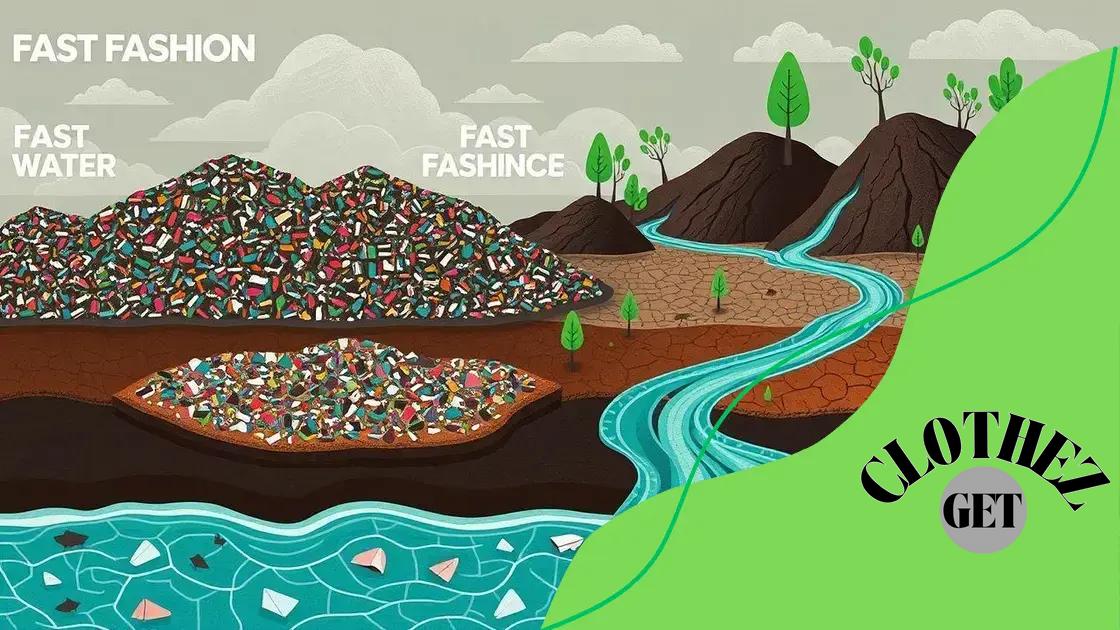Shein’s response to sustainability challenges: what it means

Shein’s response to sustainability challenges centers on improving material innovation, enhancing transparency, and engaging consumers in eco-friendly practices to effectively navigate the evolving market demands.
Shein’s response to sustainability challenges is a crucial topic in today’s fashion industry. Consumers are increasingly concerned about the environmental impact of their purchases, prompting companies like Shein to adapt their practices. But what exactly are they doing to address these issues?
Overview of Shein’s sustainability initiatives
Understanding Shein’s sustainability initiatives is essential for grasping their role in the fast fashion industry. They are making strides to address environmental concerns, and this overview will highlight their key efforts.
Commitment to Sustainable Materials
One significant area of focus is the use of sustainable materials. Shein is shifting towards fabrics that are more eco-friendly. For example, they are incorporating recycled polyester and organic cotton in their collections.
- Recycled fabrics reduce waste and energy consumption.
- Organic materials minimize harmful chemicals used in production.
- Innovative textiles, like Tencel, provide more sustainable options.
Another aspect of Shein’s approach is their commitment to transparency. They have started sharing information about their supply chain and production processes. Consumers are increasingly demanding more transparency from brands, and Shein’s response aims to build trust.
Efforts to Reduce Waste
In addition to sustainable materials and transparency, Shein is taking steps to reduce waste. They are implementing measures to minimize excess inventory. This not only helps the environment but also aligns with consumer preferences for limited collections.
They also encourage recycling through programs that allow customers to return unwanted items for reuse. Such initiatives foster a culture of sustainability and help reduce the overall impact on the planet.
Despite these efforts, critics highlight the challenges Shein faces. Fast fashion inherently presents conflicts with sustainability. Balancing rapid production with eco-friendly practices is a complex task. The conversation around Shein’s sustainability is ongoing.
Ultimately, what remains crucial is how these initiatives evolve over time. As consumers become more discerning, Shein’s ability to adapt will be key to their success in a changing market.
Key challenges Shein faces in sustainability
Shein is advancing its sustainability efforts, but it faces significant challenges. Understanding these key challenges Shein faces in sustainability helps to provide a clearer picture of the complexities involved in the fast fashion industry.
High Production Volume
One of the biggest hurdles is the high production volume typical of fast fashion. Shein produces a vast array of products quickly to meet consumer demand. This leads to increased resource consumption and waste, making it hard to maintain sustainable practices.
- Fast production cycles create pressure to use cheaper, non-sustainable materials.
- Overproduction can lead to unsold inventory that ends up in landfills.
- Reducing production time while increasing sustainability adds to operational challenges.
The rapid nature of the fashion seasons complicates Shein’s commitment to sustainable practices. There’s a constant push for new styles and trends.
Supply Chain Transparency
Another challenge is achieving supply chain transparency. Shein’s extensive network of suppliers can make it difficult to ensure ethical practices. Gaining oversight of all production processes is essential for sustainability, yet it’s complex and demanding.
Many consumers are calling for brands to disclose their supply chain details. Shein is working on improving this aspect, but establishing genuine transparency requires time and effort.
Moreover, the need for third-party audits and ethical verification adds layers of complexity. These measures are critical to building trust but can be an expensive and time-consuming process.
Consumer Expectations
Shein also contends with growing consumer expectations for sustainability. Shifts in public awareness are pushing fast fashion brands to act responsibly. However, transitioning to sustainable practices can be resource-intensive and may impact pricing.
- Consumers often expect lower prices, which can conflict with sustainable materials and production methods.
- Negative perceptions about fast fashion’s environmental impact challenge Shein’s reputation.
- Finding the balance between profitability and eco-consciousness is ongoing.
Ultimately, although Shein is making strides, overcoming these substantial challenges remains a formidable task. The sustainability landscape is evolving, and adapting to new norms and expectations will be vital for their long-term success.
Impact of fast fashion on the environment

The impact of fast fashion on the environment is profound and far-reaching. As brands like Shein produce clothes at an unprecedented rate, the consequences for our planet become increasingly alarming.
Resource Consumption
First, the production of fast fashion requires a significant amount of resources. The fashion industry is one of the largest consumers of water globally. For instance, it takes about 2,700 liters of water to produce one cotton t-shirt.
- A high demand for cotton leads to pesticide use, harming ecosystems.
- Water pollution from dyeing processes significantly affects local waterways.
- Unsustainable farming practices reduce soil health and biodiversity.
This high resource consumption exemplifies the unsustainable practices often associated with fast fashion.
Textile Waste
Another major environmental concern is the amount of textile waste generated. Fast fashion contributes to a throwaway culture where clothes are not worn for long periods.
Every year, millions of tons of clothing are discarded, with a substantial portion ending up in landfills. In fact, the equivalent of one garbage truck full of textiles is dumped every second.
Carbon Footprint
The carbon footprint of the fashion industry is staggering. Production processes typically rely on fossil fuels, leading to high greenhouse gas emissions. This is exacerbated by shipping and transportation.
- Fast fashion accounts for about 10% of global carbon emissions.
- Air and sea transport of garments add to the pollution crisis.
- Consumer habits amplify this issue through frequent purchases.
As consumer awareness grows, the environmental impact of fast fashion cannot be ignored. Brands like Shein are beginning to face scrutiny over these practices and are under pressure to improve.
Finding sustainable alternatives and reducing waste will be essential for mitigating these effects. The need for change in the industry is urgent, and the responsibility lies not only with the brands but also with consumers.
Consumer response to Shein’s practices
The consumer response to Shein’s practices is a vital area of discussion as the brand navigates its role in the fashion industry. With the rise of social media and increased awareness about sustainability, consumers are more informed than ever.
Shift in Buying Habits
Many shoppers have started to shift their buying habits in response to concerns about environmental impact. They are increasingly favoring brands that promote sustainability and ethical practices. This change is reflected in the demand for more transparency from brands.
- More consumers are seeking information about where and how products are made.
- They prefer companies that use eco-friendly materials.
- There’s a growing trend towards supporting local businesses and sustainable fashion.
This shift often puts pressure on brands like Shein to adapt to new consumer values.
Social Media Influence
Social media plays a significant role in shaping consumer opinions. Many influencers and activists highlight sustainability issues, often criticizing fast fashion practices. As a result, Shein faces criticism from vocal communities that advocate for sustainable fashion.
Online platforms serve as a space for consumers to express their concerns and demand accountability. This feedback influences public perception and challenges Shein to take action.
Emerging Alternatives
In response to Shein’s practices, more consumers are exploring sustainable alternatives. Thrift shopping, rental services, and brands that prioritize ethical production are gaining traction.
- Thrift stores offer a way to reuse clothing, reducing waste.
- Clothing rental allows consumers to wear trendy items without the commitment to purchase.
- Sustainable brands with transparent practices appeal to eco-conscious shoppers.
This growing interest in alternatives pushes Shein to reconsider its strategies and practices. From marketing new eco-friendly collections to enhancing transparency in their supply chain, Shein’s future may hinge on its ability to respond to consumer expectations and trends.
Future outlook for Shein’s sustainability strategy
The future outlook for Shein’s sustainability strategy is a topic of significant interest as the brand seeks to adapt to changing market demands. The fashion industry is evolving, and Shein faces both challenges and opportunities in its path towards sustainability.
Innovation in Materials
One of the key areas for Shein’s future is the innovation in materials. The brand is exploring sustainable fabrics, such as organic cotton and recycled polyester. By investing in these materials, Shein could reduce its environmental footprint.
- Developing partnerships with fabric suppliers committed to sustainability.
- Researching new eco-friendly textiles that minimize waste.
- Implementing technologies to recycle old garments into new fabrics.
This innovation can position Shein as a leader in sustainable fashion, appealing to eco-conscious consumers.
Transparency and Accountability
Shein’s ability to improve transparency and accountability will be critical for its sustainability strategy. Consumers are demanding more information about where their clothing comes from and how it is made.
Increased transparency could involve sharing details of the supply chain, labor practices, and environmental impact measurements. Being open about these factors can build trust with customers.
Consumer Engagement
Engaging consumers in sustainability initiatives offers another dynamic avenue for Shein’s future. By promoting recycling programs and encouraging responsible shopping practices, Shein can foster a more sustainable mindset among its customers.
- Launching campaigns that educate consumers about sustainability.
- Creating rewards programs for eco-friendly actions, like recycling clothing.
- Involving customers in sustainability-led decisions through surveys and feedback.
The company’s success in this area will greatly influence its reputation and sales.
Regulatory Compliance
As environmental regulations become stricter, Shein must also stay ahead of compliance requirements. Anticipating changes in laws and regulations can help the company avoid penalties and adapt more quickly to a sustainable model.
Investing resources into understanding these regulations will aid Shein in making informed decisions about its production practices.
The path toward sustainability is not without its challenges, but by focusing on innovation, transparency, consumer engagement, and regulatory compliance, Shein can improve its sustainability strategy and contribute positively to the fashion industry.
Shein’s journey towards sustainability is a complex yet crucial one. As consumer awareness increases, Shein faces greater pressure to adopt responsible practices. By focusing on innovative materials, enhancing transparency, engaging with their audience, and complying with regulations, Shein can pave the way for a more sustainable future. The actions taken today will shape the brand’s reputation and contribute to positive environmental impact. Embracing sustainability is not just an option for Shein; it is essential for its survival in a competitive market where consumers demand accountability and responsibility from their favorite brands.
FAQ – Frequently Asked Questions about Shein’s Sustainability Practices
What steps is Shein taking towards sustainability?
Shein is focusing on using sustainable materials, increasing transparency, and engaging consumers in eco-friendly initiatives.
How can consumers influence Shein’s sustainability practices?
Consumers can influence Shein by demanding transparency, supporting sustainable brands, and participating in recycling programs.
What challenges does Shein face in becoming sustainable?
Shein faces challenges such as high production volume, the need for supply chain transparency, and meeting consumer expectations.
Why is transparency important for Shein’s brand reputation?
Transparency helps build trust with consumers, showing that Shein is committed to responsible and ethical practices.


